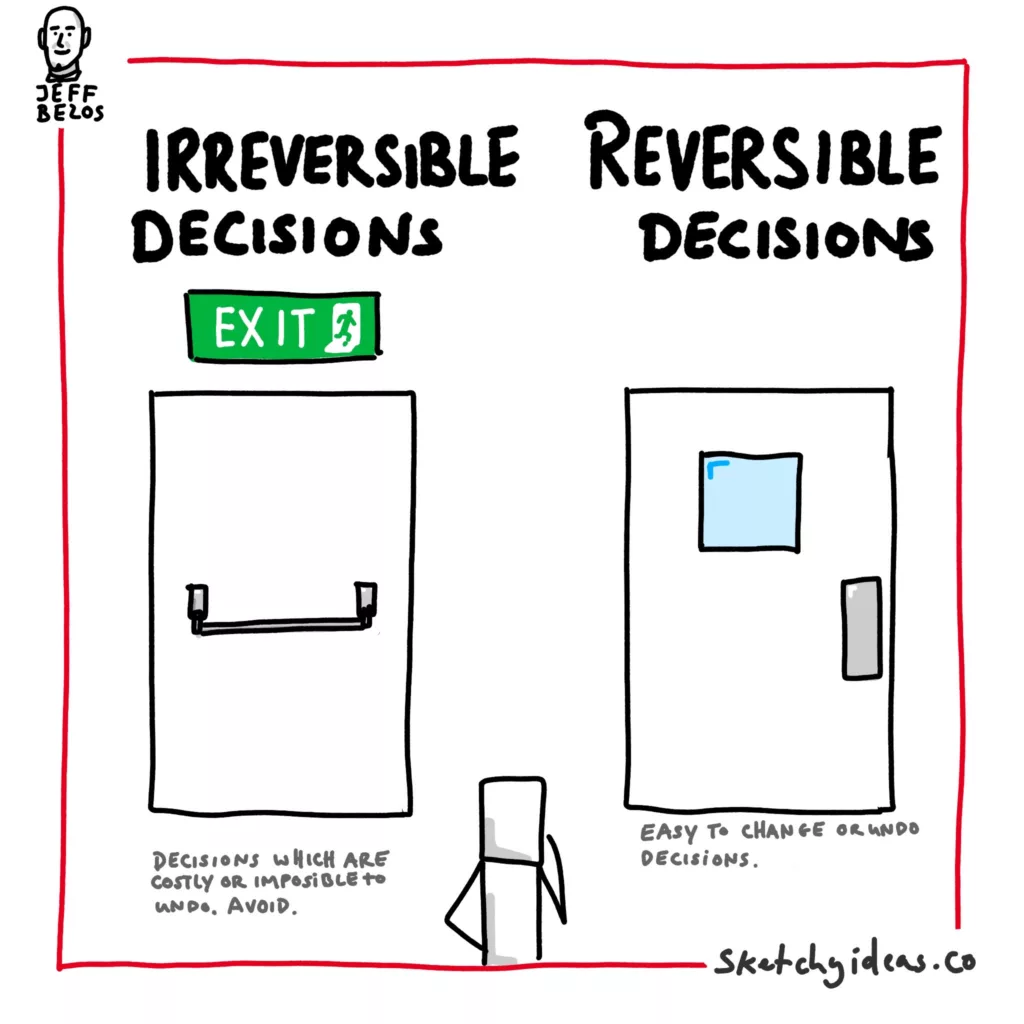Overthinking is a common excuse to taking action.
But rushing into life-altering decisions can be disastrous. So how can you make sure you give decisions the amount of time they need to avoid procrastination by overthinking while also not recklessly rushing in?
The simple mental model of reversible vs irreversible decisions can help guide you. Here’s what it is, why it’s so useful and how to apply it.

What are Reversible Decisions?
Reversible decisions are those that can be easily undone or altered without significant consequences.
Most decisions we face every day fall into this category:
- What exercise routine should I do today?
- What should I eat for breakfast?
- What should I wear?
These are easy to try and change course if we regret our choice. But even decisions with bigger consequences can be reversible ones. For example, the decision to start a new hobby may have profound impacts on your life, but trying it for the first time is only a small decision.
In contrast, irreversible decisions are ones which are difficult to undo.
For example, quitting your job, starting a family, or major financial investments with associated penalties.
These pandora’s boxes have real and lasting consequences meaning they need to be approached with care.
The Freedom of Reversible Decisions:
Reversible decisions give us the freedom to take low risks.
Realising that we can undo a decision helps us to take action sooner instead of waiting around until we are sure. This provides massive benefits as
- We may never be “ready” until we start
- Starting helps us gather data we couldn’t otherwise
- Even when we take the “wrong” action, it helps to eliminate that choice and direct us to the next.
Reversible decisions help us to test and correct our assumptions in a way that daydreaming and prognosticating can never do.
The rarity of completely irreversible decisions
Decisions aren’t really binary between reversible and irreversible.
They live on a spectrum as the cost of reversing them increases. Take the example of getting married. You could get divorced but that is a costly action (mentally as well as financially!). So while it may be practically reversible, it should be consider irreversible.
But we can make irreversible decision more reversible.
Making irreversible decisions, reversible
Binary thinking makes us assume there are only two options: quit my job or stay here forever.
That’s rarely the case. We actually have a plethora of options available to us and most are more reversible and less risky. Take quitting your job. Instead of viewing it as a binary stay/go, you could
- Try a different role in the same company
- Reduce your hours
- Start the job you want as a freelancer on the side
- Test out a new career path through pro bono work or shadowing someone
- Take an extended holiday or sabbatical
These decisions are more reversible but can lead to the same conclusion without the risks associated.
Navigating truly irreversible decisions with care:
Some decisions will always practically or factually irreversible no matter what we do.
In these situations, we need to approach them correctly, evaluate the potential outcomes and risks. Sometimes a decision is irreversible but has little associated cost (such as singing a karaoke song to friends at home.), but other times they can have huge risks and associated costs requiring proper thought.
Using Decision-making frameworks can help greatly, as well as getting outside advice from a mentor, expert or mastermind group.
Conclusion
The mental model of reversible vs. irreversible decisions can help us avoid overthinking low state decisions and help us minimize the risks of higher-stake choices.
And when truly irreversible decisions come along, we can approach them with care and appreciate the sea changes they bring in our lives.

Leave a Reply